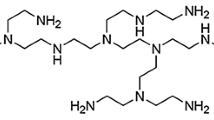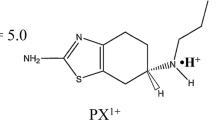Abstract
Bulk fluid flow or volume flow in the direction of counterion flow is a probable mechanism for enhanced flux of uncharged species by iontophoresis. Both the electrical volume force effect, resulting from the interaction of the “ion atmosphere” and the electric field, and an induced osmotic pressure effect produce volume flow in the same direction as counterion flow through the membrane. Since each of these effects is proportional to the membrane charge and the imposed electric field, we classify both as electroosmotic flow. This research develops a detailed theoretical model which allows the effect of volume flow on flux enhancement to be evaluated. A detailed theoretical result for the electroosmotic flow coefficient also results from the analysis. The model assumes that transport occurs in three types of aqueous pores: positively charged, neutral, and negatively charged. For hairless mouse skin (HMS), pore size, charge, and number are evaluated from transference number, volume flow, and electrical resistance data. The flux enhancement ratio is J 1/J 1 D= ΣA iαi/[l –exp( –αi)], where i = pore type, and the summation runs over the three pore types. A i is the area fraction of pore type i effective for transport; J 1 and J 1 D are flux of species 1 with and without the electric field, respectively; and αi is given by αi = F(–ΔΦ/RT)[ z 1 + (−z m i)Bar i 2 C m i(G i + F)]. Here F = Faraday's constant; −ΔΦ = voltage drop; R = gas constant; T = absolute temperature; z m i = charge of pore i; C m i = charge concentration in membrane pore of radius, r i; B is a known collection of constants; a is the Stokes radius of the transported solute; G i, is a function of membrane charge and pore radius coming from the electrical volume force effect; and F is a function of membrane charge and ion mobility arising from the induced osmotic pressure effect. For transdermal iontophoresis, F <<G, and the induced osmotic pressure effect is not significant. Negative pores dominate electroosmotic flow and usually dominate flux enhancement. The term proportional to C m i is the contribution of electroosmotic flow and will always increase the flux enhancement ratio for anodic delivery of a positively charged ion (z 1 > 0) or a neutral species (z 1 = 0) in a negatively charged pore. The theoretical results are consistent with data in the literature.
Similar content being viewed by others
REFERENCES
P. Tyle. Pharm. Res. 3:318–326 (1986).
L. Gangarosa, N. Park, C. Wiggins, and J. Hill. J. Pharmacol. Exp. Ther. 212:377–381 (1980).
R. Burnette and D. Marrero. J. Pharm. Sci. 75:738–743 (1986).
R. Burnette and B. Ongpipattanakul. J. Pharm. Sci. 76:765–773 (1987).
D. G. Miller. Chem. Rev. 60:15–37 (1960).
N. Lakshminarayanaiah. Chem. Rev. 65:491–565 (1965).
Y. Kobatake, M. Yuasa, and H. Fujita. J. Phys. Chem. 72:1752–1757 (1968).
P. H. Barry and A. B. Hope. Biophys. J. 9:700–728 (1969).
P. H. Barry and A. B. Hope. Biophys. J. 9:729–757 (1969).
J. C. Keister and G. B. Kasting. J. Membr. Sci. 29:155–167 (1986).
M. J. Pikal and S. Shah. Pharm. Res. 7 (3):213–221 (1990).
M. J. Pikal and S. Shah. Pharm. Res. 7 (3):222–229 (1990).
D. G. Miller. J. Phys. Chem. 70:2639–2659 (1966).
M. J. Pikal. J. Phys. Chem. 75:3124–3134 (1971).
A. W. Adamson. Physical Chemistry of Surfaces, 2nd ed., Interscience, New York, 1967, pp. 209–214.
G. S. Manning. J. Chem. Phys. 46:4976–4980 (1967).
R. B. Bird, W. E. Stewart, and E. N. Lightfoot. Transport Phenomena, John Wiley & Sons, New York, 1960, pp. 43–47.
K. Valia and Y. Chen. Drug Dev. Ind. Pharm. 10:575–599 (1984).
R. R. Burnette and B. Ongpipattanakul. J. Pharm. Sci. 77:132–137 (1988).
R. R. Burnette and T. M. Bagniefski. J. Pharm. Sci. 77:492–497 (1988).
H. Rein. Z. Biol. 81:125–140 (1924).
R. L. Bronaugh, R. F. Stewart, and E. R. Congdon. Toxicol. Appl. Pharmacol. 62:481–488 (1982).
B. Idson. J. Pharm. Sci. 64:901–924 (1975).
Author information
Authors and Affiliations
Rights and permissions
About this article
Cite this article
Pikal, M.J. Transport Mechanisms in Iontophoresis. I. A Theoretical Model for the Effect of Electroosmotic Flow on Flux Enhancement in Transdermal Iontophoresis. Pharm Res 7, 118–126 (1990). https://doi.org/10.1023/A:1015816532532
Issue Date:
DOI: https://doi.org/10.1023/A:1015816532532




